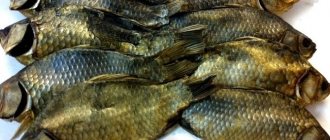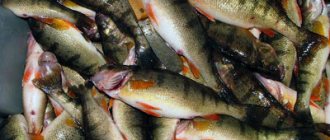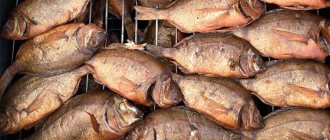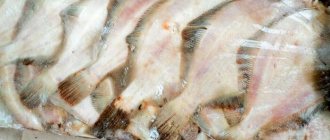How to pickle perch: 3 popular recipes
There is no difficulty in salting perch for drying. The main thing is to strictly follow the instructions and observe the proportions of sometimes preparing the saline solution. If you wish, you can watch a video on how to salt perch at home.
You can salt fish in various ways: using dry, wet or spicy pickles.
How to dry-salt perch
- Wash the fish well, remove the scales, gut it, remove the gills and dorsal fin.
The perches will be salted for 5-10 days. Then you can hang them to dry. When the perches stop producing liquid and dry out, you can enjoy them.
Wet salting of perches
- A layer of salt (3 ml) is poured onto the bottom of the pan.
- Cleaned and washed fish are laid out in dense rows.
- Each row of fish is covered with a generous layer of salt.
- The fish laid on top is completely covered with salt.
- Cover everything with a lid and put pressure on top.
- The fish is left to salt for 4-5 days in a dark, dry room (you can leave the container with perches on the bottom shelf of the refrigerator). After the specified time, the fish is removed and soaked in clean water (for 5-6 hours). When the excess salt is gone, the fish is hung to dry.
How long the ram will take to dry will depend on the size of the perch, the degree of fat content, and the ambient air temperature.
How to salt perch using spicy salting
To salt perch, you can use a salting scheme similar to the previous one. The difference is that between the rows of fish, along with salt, spices are placed (bay leaf, black peppercorns and sweet peas).
You can make taranka using this version of spicy salting. For this:
- In a separate bowl, mix pepper, salt, mint (dried and finely ground).
- Rub the cleaned fish thoroughly with the resulting mixture.
- Place the perches in layers in a pan, season each layer with salt, catch the laurel leaves and pepper.
- Cover the top layer completely with salt.
- Cover the container with fish with a lid and press down on top.
After four days, the perches are taken out and washed under the tap. Then they are left to soak in water for two and a half hours. After the excess salt is gone, the fish is hung to dry.
How to pickle perch for drying
No matter how strange it may sound, drying and drying are almost the same thing. However, there is one difference. In order for the dried perch to take its correct form, they should be placed in the sun. You can dry perches this way at home in 60–120 minutes.
During this period, the carcasses will release a small amount of fat, which will dry out and give the perches an amber tint, and make their meat a little transparent.
For this recipe the following ingredients are used:
- 2 kg of perches;
- 500 g coarse salt.
If necessary, you can add a small amount of bay leaves, allspice peas and other fish herbs to taste.
Delicious perches can be prepared according to the following instructions:
- Inspect the carcasses for signs of spoilage. They should not have strange spots, unpleasant odor, cloudy eyes or other defects.
- Wash and cut the fish, gut them and remove the eyes and gills. After this, dry each carcass well with a natural, clean cloth.
- Rub each fish well inside and out with salt, making sure to avoid hard-to-reach areas.
- After this, place them in an enamel container of a suitable size so that they lie very tightly. The bellies should be turned up.
- Pour the remaining salt into a container and cover everything with a lid of a smaller diameter and place pressure on top.
- After 3–4 days, remove the perches from the resulting brine and rinse them from mucus in running water.
- Place them on the table and allow excess moisture to drain. After this, prepare them for drying.
- Thread each carcass through the lip or eye socket onto a wire or fishing line and hang it in a shaded, ventilated place. A balcony is ideal.
- Insert toothpick spacers into the bellies. After that, protect them from insects.
After 3 - 4 days, you can remove the fish, lay it out in the sun for 40 - 60 minutes and call friends. The cured meat in the finished dish will have a pleasant amber and slightly golden hue, and if you look through it into the light, it will be slightly transparent. They prefer to eat this treat with boiled potatoes or foamy drinks.
How to salt perch using the hanging method
To salt fish using the hanging method, you need to:
- Make a strong saline solution (the potato tuber should not drown in it).
- Add spices (cumin, bay leaf, black peppercorns and sweet peas) to the pickling liquid.
- Place the fish in the solution (so that the fish do not touch each other).
- Hang the container with fish (in solution).
After a week, the fish is taken out, wiped dry with napkins or a dry, clean cloth and dried in a dry, warm room.
How to dry perch
In order for the perch to dry better and faster, they are hung by the head and not by the tail (so that the fat does not leak out). The edges of the abdomen are moved apart and wooden sticks are inserted there (this way the air will be well ventilated and the fish will not spoil).
An indicator that the ram has dried will be the hardening of its carcass on all sides.
How to properly pickle perch
Perch is one of the most common types of fish in our country. In addition to its widespread availability, it has lean, tender meat, which contains many useful substances. Perches are fried, baked, and fish soup is prepared from them. If there is a need to prepare this fish for future use, then one of the options is salting.
The principle of salting perch is that the salt with which the product is processed removes excess moisture and thereby contributes to its longer storage.
How to salt fish correctly: useful tips
Fishing is a responsible and important matter. But it’s much more important to cook it correctly and preserve the fish caught on a fishing rod.
To ensure that perches are tasty and healthy, and that eating them is a pleasure for yourself and your loved ones (or guests), it is important to follow simple rules.
- It is better to use plastic or glass containers for salting fish.
- You don’t have to remove the insides of small fish; they are salted and dried whole.
- To ensure that the salted fish is well soaked and not overly salty, the soaking water is sometimes changed every 60 minutes.
- It is best to dry fish at a temperature of 18 degrees.
- It is best to hang fish for drying by the head (a thread, scraper or fishing line is threaded through the eye sockets; this will prevent the fat from dripping onto the ground).
- It is better to dry fish in spring or autumn, when the air temperature is not too high (this will reduce the risk of meat rotting and improve its taste); Drying fish in winter is not recommended.
Every fisherman has in his arsenal many recipes for how to deliciously dry perch. To make the fish different in its taste, you can use spices and herbs when salting. When drying fish, it is important to follow the technology: use a sufficient amount of salt, dry at the correct temperature, do not hang fish carcasses to dry in cold and damp (or, conversely, too hot) rooms, avoid (if possible) the presence of insects near the drying area. This can cause the salted perch to completely deteriorate and become unedible.
How to dry perch
Dried fish is a traditional Russian dish. In Russia, it is customary to dry both sea and river fish, and a variety of species are used for this. The process involves pre-salting the fish, followed by soaking and drying it under natural or artificial conditions. As a result of dehydration and further ripening, it acquires a special taste and smell, as well as a certain consistency due to compaction of the pulp. Its dried meat takes on an amber hue and becomes translucent.
Despite its apparent simplicity, this is not an easy task, and it takes a lot of time. A novice fisherman, in order not to spoil his catch, needs to pay attention to many nuances. The best quality is obtained from fish that was salted on the day of catch.
How to dry river perch
The process of drying perch is similar to the method of preparing dried fish. We have already described general recommendations for drying fish in the article “ How to dry fish at home ,” in which you will find recipes and tips for drying any fish.
The differences lie in the time required to obtain the dried product and the method of hanging the fish:
- the drying procedure takes from five to eight days;
- for this cooking method, fattier specimens are chosen;
- It is better to hang carcasses head up - this promotes uniform distribution of internal fat;
A richer taste appears if, after drying, the product is kept for one to two weeks.
How to dry river perch
River perch turns out to be somewhat dry, with a specific taste. As experienced fishermen say, it is fattier and tastier before spawning, that is, caught in winter or early spring. In the warm season, it is better to dry perch in the spring, before the heat sets in, or closer to autumn, when there are no flies. In the summer heat, the salting and soaking time will be long, and much more salt will be needed. There is a great risk that rotting will begin under the scales quickly seized by salt.
Preparation
For drying, it is advisable to take perches of approximately the same weight, since the salting period for small and large specimens is different. Ideally, these should be fish weighing 200-300 grams. In the warm season, 300 grams of coarse salt per kilogram of fish is needed; in winter it will be needed 2-3 times less.
In summer and in the spring-autumn period, the fish must be gutted, otherwise, if you leave the guts, you can ruin the entire salting. The gills are also removed, but the scales must be left behind. The perches are washed to remove mucus in cold water and then gutted. Cut fish is not washed. To make the fish tastier, the belly can be left uncut, and the entrails removed through a cut near the ridge. Some fishermen remove dirt with a rag, believing that washing spoils the taste. In winter, do not gut small fish, as this will make them fatter.
Pickling
Salting can be done dry or wet. Dry is more suitable for larger specimens. A box or basket is used as a container, with a piece of fabric placed at the bottom. The inside of the carcasses is rubbed with salt, then they are placed tightly in a box with their bellies up, tails to the head. Sprinkle salt on top, place plywood or something flat and press down with pressure, for example, a stone, to remove air from bubbles and compact the meat. The released liquid will flow through the cracks in the box or basket. The salting time lasts from 5 to 10 days. If you dry salt a small fish, you don’t have to remove the insides: they place it in a box on a rag, sprinkle it generously with salt, cover it with the other end of the rag and put pressure on top.
Most often, perch is salted using the wet method. To do this, pour salt into the bottom of the container - approximately 3 mm. The fish are laid in rows quite tightly so that each fish rests its belly against the back of the other, and its head against the tail. Sprinkle all rows with salt, generously on the top row so that the perches are completely covered. You can optionally place bay leaves and spices between the rows. Cover it in a circle and put pressure so that it crushes the fish. Place in a cool place (refrigerator or cellar) so that the meat, which has not reached the salt, does not spoil. After salting, a brine begins to form, and in about two days it will cover all the fish. The resulting brine should be transparent. If it is cloudy and reddish, the fish has begun to spoil. Salting will take approximately 3 to 7 days, depending on the size of the fish. The finished perch has hardened meat; if you pull the tail or head, you should hear a crunch, as if the back is being pulled towards the ridge. If these signs are not present, you need to keep the fish in brine for another day.
Flushing
After salting, soaking in cold water is necessary. Dried perch should not be too salty, with amber-colored meat. The duration of rinsing depends on the duration of salting. There is a rule: for every day of salting, there is an hour of soaking. The perches are placed in a container with a large amount of cold water and washed by hand, the scales should not fly off. Then leave for several hours. It is important not to keep the fish in the water too long, otherwise its outer layers will become soggy. You can try the perch for its salinity level.
Some recommend rinsing the perch under cold running water for 10 minutes to remove any mucus, remaining salt and spices. For lovers of lightly salted fish, the washing time can be slightly increased.
Drying
When the washing is completed, the water is allowed to drain, and the perches are placed in a well-ventilated place, but without sun, in a suspended form. Ideal drying conditions are outside at a temperature of 18-20⁰C. It is recommended to pass the line through the eye or lower lip to preserve the internal fat in the fish and thus make it more tasty.
Instead of fishing line, you can use homemade hooks made from steel wire, cut and bent in the shape of the letter Z, or regular paper clips. To help the fish dry faster, you can insert toothpicks into the bellies.
Readiness is checked after about six days. If the fish is still raw, leave it to dry. On average, the drying process takes 5-8 days, and it is already ready to eat, but it takes three to four weeks to reach full maturity.
To speed up the process, you can hang the perches above the gas stove, but lower than 80 cm from its surface. In this case, the fish will dry out in three days. You can dry perch in a well-ventilated attic or balcony, as well as in a cellar. In the latter case, it will have to be dried in a warmer place.
How to dry perches correctly
Many beer lovers, and not only others, are accustomed to calling any dried fish a roach. In fact, any type of river fish can be dried; one of the most delicious options is dried perch.
Perch intended for drying should be medium in size, weighing from 100 to 500 grams. Fresh perch must be thoroughly washed in cold water; if desired, you can gut it. Salt is poured onto the bottom of a plastic or enamel dish (the layer can reach 3 mm), perch is placed on top, and the fish should lie in a fairly dense layer, for this it is laid in a certain order - the tummy of one fish to the back of another, the head of one to the tail of another. A layer of fish is generously sprinkled with salt, then the next layer of fish is placed. If desired, to add a special taste and aroma to dried fish
, between the layers you can put a few bay leaves and spices for salting the fish. The last layer of fish should be completely covered with salt. The fish is covered with a lid slightly smaller than the diameter of the dish, on which a load weighing about 2 kg is placed. The dishes with fish are placed in a cold and dark place; if the container allows, it can be placed on the bottom shelf of the refrigerator. Salting of fish lasts about 3 days.
After the allotted time has passed, the perches are removed from the salt and thoroughly washed under cold running water; all remaining salt, spices and mucus must be drained. As a rule, 5-10 minutes are enough for this, but if you want to get lightly salted perch, then the washing time can be increased. After this, the fish should be left for a while so that all the water is drained, wiped dry with a towel and can be hung out to dry.
How to dry fish
in general and, most importantly, how to dry perches correctly? From practice it is known that it is best to hang a perch by threading a rope through the lower lip or through the eye. Thus, the internal fat remains in the fish, and it turns out more tender. Instead of a rope, you can use ordinary paper clips to hang perches, or you can make several hooks yourself; for this you will need elastic steel wire, which you need to cut into pieces and bend them in a Z shape.
You can hang perches to dry in any well-ventilated place - in a fishing line, if possible, or on a balcony. Drying on the balcony should only be done if the weather is warm and dry outside and there are no clothes drying on lines, otherwise you risk giving your clothes a persistent aroma of dried perch.
In such conditions, the perch is dried in 5-8 days.
To speed up the drying process, you can hang the fish over a gas stove, but at a distance of no less than 80 centimeters. Your desire to speed up the process even more by hanging the fish very low above the stove may result in the perch simply being cooked. If the fish is not gutted, the giblets will heat up and the meat will acquire a very unpleasant smell and taste. As a rule, perch is dried over a gas stove in 2-3 days. You can store dried perch in the refrigerator, wrapped in plastic wrap. Properly dried perch can be stored in such conditions indefinitely. Found a mistake?
Select it and press
Ctrl+Enter
. We will be grateful for your help.
Category: AT HOME |
632 | Complaint
Estimate:
- 80
Recipe for curing sea bass
To dry sea bass, you need to take carcasses weighing from 0.5 to 1 kg, preferably the same size.
When choosing fish, be sure to pay attention to the following points:
- The eyes should be round, transparent, not sunken.
- The tail and fins must not be broken.
For 5 kg of fresh frozen fish you will need a kilogram of coarse non-iodized salt.
To begin, the perch needs to be defrosted naturally at a temperature no higher than 18⁰ C. If the carcasses break off well from each other, you can start salting.
To pickle, take an enamel basin or bucket and rinse it with cold water. Roll each carcass in salt and place it in rows crosswise tightly to each other, sprinkling each row with salt. Pour the remaining salt onto the last row, cover with a wooden circle, plywood or flat plate, and press with a weight of about 3 kg. This could be a three-liter jar of water.
The fish can be left at room temperature, but it is better to place it in a cool place for 3-6 days. After the expiration date, stir the carcasses and pour them into a bath of cold water, where they keep for 4 hours. Then rinse each fish under cold running water.
They pierce the fish in the tail section with an awl and hang it on hooks for two to three hours to drain the water. After this, they are taken out into a draft, it is advisable that the temperature does not exceed 25⁰C. If there are significant differences in daytime and nighttime temperatures outside, the perch should be brought indoors at night. It takes about 3-7 days to dry the fish, depending on what condition you would like to achieve.
In winter, it is impossible to achieve the same ripening of fish as in summer, since only in the fresh air with low humidity is it possible to obtain a high-quality product. In winter, indoors, the process goes faster due to heat, and the fish does not have time to acquire an amber color and transparency.
How to dry perch? (video)
Drying tips and recipes:
After the fish is washed, it is hung out to dry. To do this, a fishing line is threaded through the lower lip or through the eyes (you can replace it with metal hooks or even ordinary paper clips curved in the shape of an “r”). You can insert toothpicks into the bellies of the fish - such spacers will slightly speed up the drying process.
Drying should be carried out in a well-ventilated but shaded place. The optimal temperature for this is considered to be 18-20°C.
After about a week, check the readiness of the fish and, if it is still damp, dry it some more. Typically, the entire process takes five to ten days, depending on the size of the snappers and the temperature at which they are dried. It can be considered completely dry only after 3-4 weeks.
If you can’t wait to enjoy the fish, then drying can be reduced to three days by hanging the carcasses over a gas stove (the distance from the fish to the surface of the stove is at least 80 cm).
A simple recipe for salted perches
The fish will last a long time if you salt it. For 10 kilos of perch you will need a kilo of salt and a bucket of water.
To salt the fish, they are prepared. Carefully remove the scales from the perches using a knife on a cutting board. The abdomen of each carcass is cut lengthwise, starting at the head, ending at the sub-caudal fin. The gallbladder and liver are removed. Next, you should start removing the gills and the first dorsal fin.
A clean, dry cloth will be needed to wipe the fish. When it comes to salting carcasses, it is better to use an enamel pan. Salt should be poured into it.
Tip: The fish on salted crystals are placed tightly in rows, the head of one should be adjacent to the tail of the other, as well as the back to the belly.
All rows of perches are generously sprinkled with salt. A layer of salt on top should literally cover all the carcasses. You should press down the fish with a board with pressure. How long the carcasses will be salted in a cool place depends on the size of the fish; on average, the period lasts from 2 to 5 days.
Salted perch is good for drying. Before drying, you need to soak the carcasses in water for about 4 or 5 hours, after which the tasty delicacy can be consumed.
Preparing fish for salting
For salting, it is best to choose carcasses of approximately the same size. The ideal weight of perch for salting is up to 500 grams. It is not at all necessary to clean a small fish of husks and entrails - just rinse it under running cold water and remove the gills.
If the fish weighs more than a kilogram, then it is advisable to clean and gut it:
- place the fish on a kitchen board and remove the scales from it;
- Using a sharp knife, make a longitudinal incision through the entire belly, remove the intestines, liver, gall bladder, caviar and milt;
- remove the gills, as well as the first dorsal fin;
- Using a clean, dry cloth or multi-layer paper napkin, thoroughly blot the fish, paying special attention to the intra-abdominal cavity.
How to remove scales (video)
Cleaning scales from a perch is a labor-intensive and thankless process, but there are ways that can make it easier:
The video describes 3 ways to clean perch, quickly and efficiently:
It is not necessary to remove the scales for salting. But if there is a need to do this, there are three simple methods:
- Scald with boiling water - the scales are removed much easier, the skin remains undamaged;
- Remove the scales along with the skin - cut the fish along the ridge and remove the dorsal fin, grab the edge of the skin and carefully cut it off the fish with a knife;
- For this method, the perch must first be frozen:
3.1. Using a knife, cut off the skin from the ridge and belly along with the fins;
3.2. Remove the tail fin;
3.3. Use a knife to pick up the skin from the side of the tail and remove it;
General recommendations for salting
If you salt the perch in a warm place, you will need more salt, about 25 percent. In this case, the ambassador will last less time.
To salt perches, use coarse salt. It is needed mainly to remove moisture from the fish.
Advice: Damage to the gallbladder is unacceptable; when it is cut or ruptured, every part of the fish that gets bile is cut out or immediately rubbed with plenty of salt.
There is no need to salt perch before freezing. It is worth freezing carcasses in plastic bags, which should be tightly tied or wrapped. Defrost perch in salty cold water.
Excessively salted fish are soaked in cold water; you can use milk that has cooled in the refrigerator for this purpose. The soaked products are filled with marinade liquid.
To ensure that the scales of the perch are cleaned well, the fish should be immersed in boiling water for a couple of seconds. To obtain the original taste of the product, granulated sugar is added to the salt during the salting process.
To know how to properly salt perch carcasses, you need to follow the recommendations of experienced chefs and fish catchers. First of all, you need to learn how to choose raw fish and cut it correctly.
It is best to use carcasses of approximately the same weight when salting. One-kilogram perches are not always gutted if desired. Fish is not washed before salting. The husks are also removed at discretion. If you are going to gut it, you need to wipe the belly from the inside using paper napkins or a clean cloth.
How to dry and dry perch?
Many people will appreciate the product of hot smoked or dried perch with beer. To dry or before smoking, you will need to purchase a fresh product and salt it. It is better to choose medium-sized fish, the weight can be from 100 grams to half a kilo. The carcasses are washed under streams of ice water. You can gut it, or you can leave the fish whole.
In an enamel or plastic container, you need to cover a three-millimeter layer of salt, and the perches will be placed tightly and in layers on top. Each row should be sprinkled with salt crystals. The bottom and last layers are sprinkled more heavily than the middle ones. The product is covered with a plate, or for this purpose a lid with a smaller diameter than the container is taken. On top you will need a weight weighing no more than 2 kilos.
Salted fish should be kept in the dark and cold. The ideal place would be a refrigerator. When the third day has passed, the perch is rinsed to remove salt, mucus and particles of seasonings, if any have been used.
To get lightly salted fish, you need to rinse them for at least 10 or 15 minutes, then let the water drain. After wiping the carcasses, they are dried on a rope, armed with paper clips, z-shaped wires or hooks, which will be needed to thread them through the fish’s eye sockets or lower lips, and thus hang them.
Stringed carcasses are hung in ventilated places, for example, on a balcony, in a garden or on a personal plot. The weather must be warm and dry, otherwise the product will not dry deliciously. The process lasts from 5 to 8 days. To dry faster, in 2 or 3 days, you can hang the fish at the top of the gas stove so that the distance between it and the product is about 80 cm. The finished perch is wrapped in cellophane and put on the refrigerator shelf; storage time is not limited. The freezer is contraindicated for dried carcasses.
Drying the perches
Sprinkle the bottom of an enamel pan with a thick (up to half a centimeter) layer of salt and carefully place the fish, tightly and neatly, so that they come into contact with each other and are quickly saturated with salt. Sprinkle plenty of salt on top of the fish, trying to avoid unsalted areas, and place the fish again. Some fans also add special spices to the salt, which can be bought in the store, as well as bay leaves. The topmost layer of fish also needs to be generously sprinkled with salt, then covered with a lid that fits freely into the pan, and pressed down with a weight of about 2 kg. The fish must lie under the load for 72 hours.
After this, the fish is removed and washed very thoroughly in running, cold water. You can hang the fish out to dry. The best way to do this is to thread the fish onto a strong twine, threading it through the fish's eyes. Some also use regular paper clips or specially bent wire in the shape of an integral - threading one end through the eye and catching the other on a stretched rope or wire. Hanging a fish upside down is a mistake. This leads to the fact that the tail dries out in a matter of hours, and the head and belly, thanks to the water flowing down, remain completely damp for a long time.
If the temperature outside is warm, the fish will dry for 5 to 8 days, but a lot depends on the air humidity, the size of the fish, and most importantly, on your taste. Some people prefer completely dry fish, while others prefer juicy and soft fish.
Smoked fish
Hot smoked fish is perfect for a picnic instead of barbecue. To smoke sea bass or river bass, the product is taken to a smokehouse. But first, raw carcasses need to be salted. To smoke 3 kilos of fish per batch, salt is needed in large quantities.
Cleaning perch for hot smoking involves gutting, but the heads and scales are not removed. The fish is washed before the process. The carcasses are generously rubbed with salt crystals; the inside of the bellies must also be salted. Wait 4 hours, rinse the product in clean cool water and begin to smoke. The wood chips should evenly cover the bottom of the smokehouse. Hot smoked fish on grills is incredibly tasty.










